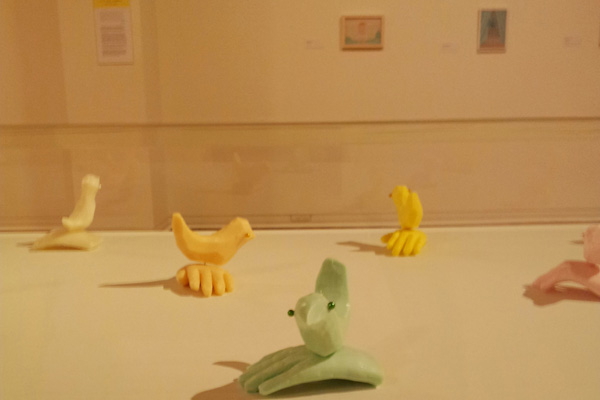Saskia Leek’s Desk Collection
DPAG | Until 08 Sep 2013
The title Desk Collection refers to Leek’s having created every painting at a desk, alluding to the exhibition’s “timeline” structure and putting the paintings’ size into perspective – they are unobtrusively small. Paintings of this scale run the risk of being swamped with expanses of white wall, but any sense of intimidation was offset by the installation itself: the paintings were placed at eye level on partitioning walls creating intimate, enclosed spaces, much like those depicted in the works themselves. As a result, the paintings and works of other media (a sculptured caravan and cabinet of beautiful soap sculptures) tie together seamlessly.
The layout of this exhibition was exceptional, guiding the visitor in the right direction, but giving them the freedom to form their own interpretations. Combining quotes from the artist herself with considered observations, the writing on the accompanying placards avoided convolution. The installation enhanced the beauty of the paintings, something that many galleries often, bafflingly, fail to do.
Recently shortlisted for the prestigious Walters Art Award, Saskia Leek has a prominent presence in the New Zealand art scene. Admittedly, her works initially failed to grab me. However, suffused with intimacy and unimposing in their scale, these paintings are designed to affect the viewer gradually. If one were simply to flick from one painting to another, their subtle grittiness would go unnoticed. A reasonable amount of time is required to discern these paintings’ beauty, and understand why Leek deserves the title of “success story” to which this exhibition pays homage.
The opening wall describes Leek’s works as a shift “from junk shop to old master.” While there is a noticeable change in her style and painting formula (with a somewhat side-tracked venture into abstraction), underlying the whole exhibition is an otherworldly and slightly dark tenor. It begins with Leek’s earlier popular culture-oriented works that elevated her to prominence as part of a group exhibition Hangover in 1995. These works present a critique on contemporary culture that references the artist’s own teenage experiences and the American iconography she was influenced by, exemplified by a self-portrait of Leek as Sandra Dee. With strong colours, witty commentary and bold figures, these works reflect the extent to which the artist’s painting style has developed.
Leek settles into a thoughtful and genuine style, with most of her paintings containing relatable subject matter like horses, houses, cats and fruit. However, the success of her works is their edgy, surrealist nature embodied in the environments in which she places these objects. The penultimate painting depicts a gathering of Victorian figures, seemingly lost in deep, green bush. Vaguely sinister, you wonder why they are there, why some figures are distorted, and just how that one little man ended up in a clearing all by himself? From a technical point of view, the works are deceptive. Seemingly simple, there is a lot the paintings provide the viewer beyond the first glance, offering the viewer not just a scene, but a story.



